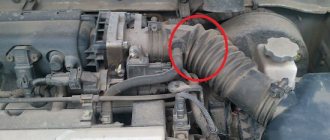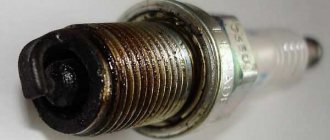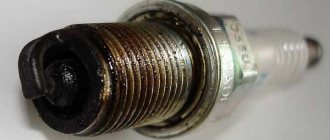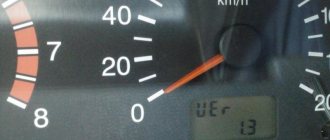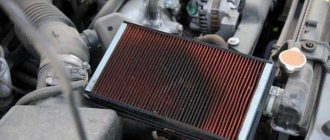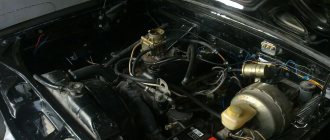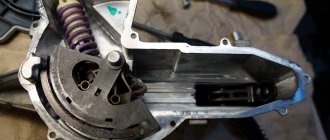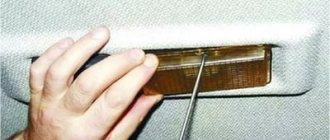Hello dear reader of the RtiIvaz.ru blog. Let's find out today and talk to you about which radiator pipes are installed on Lada VAZ 2108, 2109, 21099, 2113, 2114, 2115 cars. Many car owners do not know what rubber radiator pipes for the cooling system are needed for and how they work. Here I’m trying to explain in simple language about RTI auto repair kits for vases, and also show on video what goes where. Forgive me if I'm wrong somewhere, since the rubber pipes of the cooling system are very difficult to understand. As a car enthusiast, I will try to explain to you about the radiator pipes for the cooling system, which ones fit where. Look at the photo and also at the video of the inlet, outlet, and bypass pipes. In general, you need to at least somehow understand the hoses on your Lada VAZ cars for a fulcrum under the hood.
Next, see a photo of the pipes of the Lada VAZ 2108, 2109, 21099, 2113 for cars with a carburetor engine:
For VAZ cars with carburetor engines
Number 1 is the “upper” pipe that “supplies” coolant from the engine to the radiator, the so-called “wave”, has the shape of a wave. And number 2 is the lower “angular” rubber pipe, which drains coolant from the radiator to the engine. At numbers 3 and 4, there is one “short” one, a bypass connects the engine head to the thermostat, and the second connects the thermostat to the water pump. Expansion barrel pipe for carburetor engines number 5. Design numbers:
- 2108-1303025 radiator supply hose number -1
- 2108-1303010 outlet hose -2
- 2108 -1303092Р thermostat coupling numbered -3; 4
- 2108-1303080 cooling system filling hose with extension number -5
You are a car enthusiast, you probably know that the upper supply hose supplies hot liquid from the engine for cooling in the radiator. And the lower outlet hose carries the already cooled liquid to the engine. This is the unusual role played by the rubber hoses of the cooling system. Next, see a photo of the pipes of the Lada VAZ 2108, 2109, 21099, 2113, 2114, 2115 for cars with an injection engine:
For VAZ cars with injection engines
Number 1 is the “upper” pipe “supplying” coolant from the engine to the radiator, “angular wave”, has the shape of an angular wave. And number 2 is the “lower” coolant discharge pipe. At number 3 is the “angle” bypass connected from the engine head to the thermostat and further to the water pump through the “short” coupling 4. At number 5 in the photo is the hose of the expansion barrel for injection engines. Design numbers:
- 21082-1303025 radiator hose, supply number -1
- 21082-1303010 outlet hose - 2
- 2109-1303093-01 connecting hose for thermostat and water pump -3
- 2108 -1303092Р thermostat connecting coupling -4
- 21082-1303080 cooling system filling hose number -5
That an injection engine and a carburetor engine also have a “antifreeze” hose of the same length and thickness for removing steam from the radiator to the expansion tank (see video). The steam exhaust hose “antifreeze” VAZ 2108-2115 differs from the steam exhaust hose VAZ 2110-2112 only in length. What is the difference between auto repair kits for radiator pipes of injection and carburetor engines, I will not describe in this auto article, look friends, you can clearly see it in the photo and video.
The cooling system gave me problems all 4 years of owning the car, either the reservoir would burst, or the throttle heating pipe would crack, then it would leak, or the heater hose would crack, and while putting this entire cooling and heating system in order, I thought for a long time about what to replace the standard pipes of the car with, The throttle heating hose burst 2 times, the heater hose in the cabin cracked and began to leak. In general, after much thought, I decided to buy expensive silicone pipes and hoses from the Salers company. I would like to say right away that this is not any kind of advertising, just in searching for information about silicone pipes I didn’t find a lot of information on them and I had very big doubts about the order - what if it doesn’t fit, what if it’s a scam, etc. Looking ahead, I’d like to to say that all the pipes and hoses fit perfectly and fit without any problems - if someone wants to order - don’t be afraid, everything will fit.
How to independently remove and replace the stove on a VAZ-2115
Heater malfunctions in any car cause a lot of trouble. It is especially difficult to correct the situation when the problem has already started and coolant has leaked.
Replacing a heater on a car is not an easy task, since in order to get to it, you will have to disassemble half the car and it will take a lot of time. Unfortunately, not everyone knows how to remove and replace the stove on a VAZ-2115, and therefore they turn to a car service center.
But you shouldn’t rush to give your car into the wrong hands because of this procedure alone, because:
- Work to replace components costs about 1500–2000 rubles.
- It’s not a fact that they will do everything efficiently.
- Very often, car service workers treat their work anyhow and can break something when dismantling the panel.
Cleaning or replacing the radiator
The radiator, located in the front of the car, absorbs the main flow of dust and dirt. For its effective operation, timely prevention and cleaning is necessary. The radiator can become dirty both inside and outside.
An indicator of internal cleanliness is the condition of the coolant. Manufacturers recommend changing antifreeze every 75,000 km or every 5 years. However, a change in the color of the liquid, severe darkening, discoloration, or the presence of rust requires urgent replacement of the coolant. It is recommended to change antifreeze at least every 40,000 km.
To carry out internal cleaning of the cooling system of VAZ 2110, 2114, 2115, it is necessary to drain the liquid. Sequencing:
- open the expansion tank cap;
- place a container to drain the antifreeze;
- Unscrew the drain plug from the cylinder block;
- drain the refrigerant;
- unscrew the radiator drain plug (located at the lowest point);
- drain the remaining antifreeze (antifreeze);
- tighten all the plugs.
https://youtube.com/watch?v=S4_K9uth77w
To clean, pour distilled water into the system and start the engine for about 20 minutes. Ordinary water contains many impurities and forms scale, so its use is undesirable. The liquid is drained several times until clean water flows out. This method is ineffective as it removes a small amount of deposits.
For more effective washing, it is advisable to use special chemical additives. The detergent components included in their composition allow you to dissolve deposits and remove various types of contaminants. The mixture of water and vinegar used by many motorists is less effective. It does not remove all deposits. After using chemicals, the cooling system is washed with distillate.
After cleaning the entire SOD of the VAZ 2110, 2114, 2115, an additional internal flushing of the radiator is carried out. To do this, you need to detach the hoses from the base and the upper and upper tank. Liquid is poured into the radiator through the upper pipe using a garden hose. Flushing is carried out until clean water flows from the lower pipe.
The removed radiator can be externally cleaned to remove dirt, insects, and sand from the cooler honeycomb. Cleaning is carried out with a soap solution or special devices that create a strong flow of water or air, for example a Karcher vacuum cleaner. The procedure should be carried out carefully so as not to bend the radiator honeycombs.
If damaged or heavily soiled, the radiator should be replaced.
Replacing the thermostat
If the thermostat valve does not operate correctly, the coolant does not circulate throughout the large circle of the ODS. The lower pipe remains cold even after the refrigerant is heated to 90°C. The top pipe may be hot due to steam escaping. The thermostat can also get stuck in the open position; in this case, the engine does not warm up to the required temperature or takes too long to warm up.
In preparation for replacing the device, it is necessary to drain the fluid from the system and remove the air filter. Then the radiator and fluid pump hoses are disconnected from the thermostat housing. After this, loosen the mounting bolts and remove the thermostat cover. The device is replaced with a working one. Attaching the thermostat is done in the reverse order.
These are the main reasons for the malfunction of the cooling system and the cold lower pipe of VAZ 2110, 2114, 2115 cars.
Sometimes, even experienced motorists wonder: why is the lower pipe on the VAZ 2114 cold? It is impossible to answer this question unequivocally; there are many reasons that lead to disturbances in the engine cooling system. One thing is clear: it is necessary to find out the cause of the breakdown and restore the system to avoid problems with the engine. Let's try to thoroughly understand everything.
Why does the stove blow cold air? Causes of malfunction
In the interior of the VAZ 2110 you can quite often see that the heater simply does not respond to the temperature regulator. The answer immediately suggests itself - one of the elements of the system has simply failed. We start looking for him.
Problems with the interior temperature sensor
First of all, we check the interior temperature sensor. It is located on the ceiling, near the interior lighting. If the temperature regulator is turned to the extreme right position, and the stove reacts to this, then the sensor needs to be changed. If everything is fine, we look further.
Problems with the heater damper
The heater damper may oxidize and jam. Many experienced owners of these cars install an aluminum damper, which better distributes air and retains heat in the cabin. But you can only get to it from under the hood.
If the stove on a VAZ 2110 blows cold air, but is itself heated to a temperature of 90 degrees, then the reason is hidden in the standard air ducts. Most likely, they are either damaged or have fallen off from the stove itself. And to get to them you will have to disassemble and remove the entire panel. If you still cannot restore them, you can simply replace them with corrugated hoses purchased from building materials and install them. And seal all joints tightly and thoroughly with polyurethane foam or modelin.
The heater radiator is clogged
If the stove on a VAZ 2110 blows cold air, then there is only one reason - the stove radiator is clogged. If the engine is cooled with water, then rust can form in the radiator, and at high temperatures, scale can also form. Small pipes in the radiator can become clogged if you (accidentally) mix antifreeze with antifreeze, this mixture will simply curdle. In addition, some short-sighted car enthusiasts add a special radiator sealant to the coolant, which also clogs the radiators from the inside. It's quite easy to check. You need to warm up the engine to a temperature of 90 degrees, turn on the heater and check the inlet and outlet pipes of the heater by touch. If the temperature on them is different, then the radiator is simply clogged and must be replaced. But the process of replacing it is quite labor-intensive.
The heater fan is broken
The stove fan may fail. Both he and his fuse are checked.
The gasket between the head and the engine block may be broken, allowing coolant to enter the cylinders. As a result, the coolant level may drop. If thick white smoke comes out of the pipe, then the gasket is definitely broken and requires immediate replacement.
If the cabin filter is clogged with dust, then there is no or almost no cold air intake to the fan of the VAZ 2110 stove. It must be immediately taken out, cleaned, and if that fails, then replaced with a new filter.
There may be a low level of antifreeze or antifreeze and there is simply not enough for the stove due to air locks in the cooling system. When the pump squeezes out and expels this plug from the system, you must add liquid.
Thermostat failure
The most common reason why the stove on a VAZ 2110 does not heat with hot air is the thermostat. It just starts to stick in the upper or lower position over time. If this happens, then you just need to replace it. But the same situation can happen to a new one. So what should we do then, change it again? There is a proven way to bring a stuck thermostat back to life.
To do this, you will need to park the car on a slight slope. In this case, the front wheels must be 25–35 cm higher than the rear wheels. The engine must be running. You need to open the hood and prepare a small wooden (precisely wooden, to avoid damaging the thermostat) stick, or the handle of a shovel. Now, once you get behind the wheel, you need to change the gas 2-3 times. Immediately go out and tap the thermostat with the butt of a stick. After this, touch all incoming and outgoing pipes near the thermostat. Such manipulations need to be carried out 3 – 5 times, after which the thermostat will work like new again.
Cracks in pipes and pipes
Another serious malfunction of the stove is coolant spilling out under your feet. There are usually two reasons. A leak in the radiator or a crack in the pipes. It is best to replace both elements, since repairs and sealing them will cost longer and more expensive.
Why can a hose in the cooling system burst?
A long vehicle life is ensured by proper care and driving style. But what to do if the car can also be affected by external factors. For example, very hot weather and constant standing in traffic jams can lead to a “boiling” of the car due to the fact that the cooling system hose ruptures.
Many car owners are faced with a similar problem and do not know what actions to take. Let's look at the reasons why this breakdown may occur.
Causes of hose ruptures. During hot weather and long waits in traffic jams, the car wears out. But what suffers most in its mechanism is the cooling system. In most cases, nodes are simply not ready for such a high load.
Some did not have time to undergo scheduled maintenance, while others decided to save money and did not go to the service center. The fact that many people violate the regulations is not surprising. The main problem lies in the consequences this leads to.
All car owners know very well that the radiator must be constantly washed, antifreeze replaced in a timely manner and only filled with what is specified in the instructions. However, the desire to save money and ignorance of technology lead to major breakdowns. Cars begin to boil, hoses break, and drivers blame the manufacturer for everything.
The very first thing to remember is to carry out diagnostics on time. It is not at all surprising that many elements in a car wear out over time, hoses are no exception. Of course, they don’t burst right away; it all starts with small cracks that develop into tears.
Among the causes of rupture, the most common is a plug in the expansion tank, or, to be more precise, a valve malfunction. A vacuum occurs in the system, the tubes begin to shrink, deform, and then burst. Repairing a traffic jam does not require large expenses; you can do it yourself, but before doing this you need to let the car cool down.
Another reason why a hose may burst is improper installation. An experienced technician will always lubricate the tube before putting it on. It’s even better if it’s warmed up beforehand.
Not all pipes need to be tightened with a clamp, and if they do, this should be done with extreme caution
Bottom line. If you properly maintain the car and choose only high-quality consumables, the cooling system can work flawlessly. In most cases, its service life depends on the driver. Therefore, you should not save on a car, because a stingy person will always pay twice.
Radiator pipes VAZ 2114
Next comes the upper radiator inlet pipe, connecting the radiator to the engine block head.
This hose goes to injection engines. Its internal diameter is 32mm, see catalog number 21082-1303025.
The next one is the lower radiator outlet pipe, which connects the radiator to the engine cooling system thermostat.
Its catalog number is 21082 – 1303010, internal diameter is 32 mm.
“Angle” pipe for connecting the thermostat to the water pump (pump).
Catalog number – 2109-1303093-01. This pipe fits almost all front-wheel drive VAZ models.
The expansion tank pipe is popularly called the “filler pipe.”
It serves to connect the expansion tank to the thermostat. Through it, antifreeze enters the cooling system when the system is filled or topped up through the expansion barrel. See catalog number 21082-1303080 for its number.
Stove pipes VAZ 2114
The pipe that connects the heater to the block head is often called “big goose” in everyday life because of its resemblance to this bird.
The hose supplies coolant from the block head to the heater radiator. We look at the catalog number 2114 – 8101206.
These considered rubber hoses are reinforced, except for the throttle heating hoses and antifreeze steam exhaust hoses.
The goose curve hose is located under the hood of the car and serves to drain coolant from the heater radiator to the water pump.
Catalog number of the crooked goose 2114- 8101208, factory BRT.
The “short” pipe connects the thermostat to the engine block head.
Shorty catalog number 2108-1303082, BRT plant.
The “small” cabin pipe of the stove supplies coolant to the radiator of the stove, through the tap, from the “crooked goose”.
Its VAZ catalog number is 2114-8101200 from the BRT plant.
The cabin “large” outlet pipe is designed to drain coolant from the heater radiator through the “big goose” hose to the water pump.
Catalog number 2114-8101204 from the BRT plant.
Under the hood, the “big goose” supplies coolant to the heater radiator through a tap. And it takes the liquid to the pump from the radiator of the “goose curve” stove through the “large” cabin hose. For example, thanks to a set of rubber pipes, coolant circulates through the heater radiator.
The rubber pipe, the so-called injection “breather”, serves to connect the valve cover of the block head with the “snail” (2111) for supplying air to the engine.
The upper catalog number of the factory breather is 2111-1014058-10.
All connections presented in the video are located under the hood and in the interior of the VAZ 2114 car, related to the cooling system. In addition to the large breather pipes, small breather pipes and volutes, which serve for the passage of air.
The car also contains well-known gas supply hoses, brake hoses, a vacuum hose, as well as windshield washer fluid supply and others. They will also need to be viewed on video and described in the article.
All rubber hoses in a car need constant replacement, as they are exposed to aggressive liquids and gradually lose their properties. They lose their elasticity, become tanned, crack and sometimes break when used for a long time without replacement.
Therefore, it is recommended to periodically review their condition and replace them if any malfunction is detected.
This video ends the review; I hope that the video will be useful to someone both for information and when servicing their car.
Watch the video
Thank you for watching the video, subscribe to the channel, write comments and ask questions.
Numbers and analogues for pipes to radiator X22XE
#1 yuriua
. I looked through everything and still couldn’t find our original 34th diameter.
I bought some kind of Tazprom CRAP - a 35-diameter corner and not only did it start to swell in the spring, but it also began to LEAK through the cord thread.
I wanted to buy blue three-layer reinforced hoses, but the price of 17 USD for a 10 cm silicone pipe is daunting.
In general, does anyone have part numbers for analogue hoses of 34 diameters?
And where to buy them in Ukraine?
32 diameter is not suggested - I couldn’t tighten it. And I WILL NOT BUY soft Tazprom hoses ANYMORE. I have a large collar on the top tank.
Thanks for answers.
Look at the Gates catalog and look for ones that are suitable in shape and length.
Then look for who sells it there
That all original pipes are bought. Or will 32 work for everyone?
#5 sueng
GP 80 Plus (Product Type 3219) Robust hose for general industrial use, eg for conveying oil, hydraulic fluids, alcohols, aqueous solutions, acids, detergents and chemicals. Conducts static electricity for greater safety. • resistance to oil, abrasion, weather conditions and ozone; • minimum burst pressure of 110 kg/cm² (11 mPa) for sizes with an internal diameter up to 13 mm (1/2”) and 90 kg/cm² (9 mPa) for larger diameters; • Temperature range from -40°C to +95°C during continuous operation, temporarily up to +110°C.
Copper stove radiator
Initially, copper has a heat transfer equal to 389.6 W/(m deg), takes a long time to heat up, and takes a long time to cool down.
The number of fins is significantly less than that of aluminum, the channels are small and quickly clog, poor fluidity at idle (by the way, this is why cool air blows at idle - the most common problem among owners of the domestic automobile industry). The copper radiator is repairable; in case of leakage, it can be soldered.
It is also worth noting that recently for the manufacture of copper radiators they use not pure copper; some paint it, which reduces heat transfer. Today there are very few high-quality copper radiators on the market, so it’s easy to run into the last slag.
Replacement
Replacement
Now all that remains is to install a new set of pipes and complete this job. For this:
- Carry out installation by following the reverse sequence of disassembly and dismantling;
- Be sure to put new O-rings in place;
- Fill the cooling system with coolant;
- Start the engine and make sure there are no coolant leaks.
As you can see, replacing the cooling system pipes can easily be done with your own hands. This will require accuracy, consistency of your actions, as well as the use of new, high-quality parts to replace the old ones.
If you cannot or do not want to deal with such issues yourself, contact a good car service center, where they can quickly and efficiently bring your cooling system to normal condition.
Loading …
Stove (heater) pipes VAZ 2114 “BRT” (4 pieces) No. 87i
Composition of the heater pipes “Repair kit No. 87i”:
- 2114 – 8101200 large internal supply pipe for the stove,
- 2114 – 8101204 small outlet pipe of the stove,
- 2114 – 801206 large motor inlet pipe, rear,
- 2114 – 8101208 small motor exhaust pipe, rear.
Retail store at Uralmash, Baku Commissars St., 113. 8 (343) 221-35-35
02. By courier for orders over 2000 rubles, in Yekaterinburg from 20:00 to 22:00
Delivery only to the entrance. Additional +100 rubles to the apartment.
02.2. By courier for orders less than 2000 rubles, by EKB from 19:00 to 22:00
Delivery to the entrance or to the gate. To the door +100 rubles for the courier.
02.3. By courier outside the EKAD, up to 20 km, from 20 to 22 h
The manager will calculate the cost of delivery and notify you by phone or mail if your phone number is not available.
After sending, we will definitely send the TRACK NUMBER of the parcel.
07. TC SDEK - careful and fast delivery
Recommended for light parcels! Inexpensive up to 10 kg and without queues, many delivery points in all large, medium and small cities, select the closest one to you on Yandex maps by entering SDEK in the search. After sending, we send you a tracking number. Fill in your full name in the Name field. Long distance payment upon receipt. Shipping is free.
05. TC "KIT" - a lot of branches
We recommend! delivery to more than 300 cities of Russia and the EAEU (Kazakhstan, Kyrgyzstan, Armenia, Belarus, Crimea). The delivery price can be checked with our manager or on the TK KIT website. After sending, we send you a tracking number. Delivery to TK KIT is FREE!
Low prices. We recommend for northern and eastern directions and Kazakhstan.
Delivery throughout Russia and the countries of Belarus, Kazakhstan, and China.
Fill in your full name and indicate the series and passport number in the comments to the order below. Delivery to TC Energia is FREE!
06. TC "Business Lines"
Prices are high with lots of markups! Attention!! TC DelLinii automatically includes services in the invoice - Insurance and Delivery by courier - but you may not be able to afford these services upon receipt, otherwise delivery with them will be twice as expensive! It is not profitable for her to carry small and inexpensive cargo. After sending the goods we send a tracking number
Please fill in your full name when ordering. In the comments to the order below, indicate the series and passport number. Payment for delivery upon receipt - the cost of sending this shopping center is indicated below.
09. TC “PEK” (series and passport number required)
Choose PEC only if there are no other options. The cost of PEC is relatively more expensive, and cargo in PEC is subject to inspection with violation of packaging, after which it is packed somehow, PEC charges various additional fees and, in general, delivery is more expensive. After sending, we send you a tracking number. Fill in your full name and indicate the series and passport number in the comments to the order. Below is the cost of the courier to the PEC branch.
12. I can’t choose! Offer the cheapest one.
To calculate delivery, please provide your full Address and Full Name; zip code, city, street, house, apt. And for foreign orders Country and exact address.
TK Luch - economical delivery to cities in the Chelyabinsk region, but shipments are not tracked and there will be problems if lost. cities: (Snezhinsk, Verkhny-Ufaley, Kasli, Ozersk, Kyshtym, Kusa, Zlatoust, Ust-katav, Yuryuzan, Katav-ivanosk, Trekhgorny, Satka, Mias, Chebarkul, Kopeisk, Korkino, Yemanzhelinsk, Yuzhnouralsk, Plast, Troitsk, Chesma , Magnitogorsk, Varna, Sibay, Kartaly, Bredy)), as well as Berezniki, Perm, Kurgan, Nizhny Tagil, Yekaterinburg, Surgut, Tobolsk, Tyumen, Shadrinsk, Shumikha, Petropavlovsk, Kostanay, Rudny, Astana, Ufa, Uchaly. Delivery costs from 100 rubles to 30 kg and from 200 rubles for 30-60 kg, between terminals. Check prices on the website of TC Luch - in some cities there are double tariffs.
Operating principle of a car heater
If the car heater “refuses” to blow warm air, then, of course, the interior will be uncomfortable and unpleasant, especially in inclement, cool weather. Having understood the principle of operation of the heater for the VAZ-2109 injector or carburetor, you can set up the operation of this device quite easily. A car heater stove can be considered a very ordinary heating device called a heat exchanger. The heating system is connected through a special tap to the system that is responsible for cooling the engine. When you turn on the stove, a special tap automatically opens, which allows cooling liquid to flow into the radiator located in the heating system. The liquid entering the radiator pipes is cooled, which leads to heat entering the cabin. The car heater is equipped with a fan that can operate in three modes. By choosing one mode or another, the driver can independently control the flow of warm air.
Stove (heater) pipes VAZ 2114 “BRT” (4 pieces) No. 87i
Composition of the heater pipes “Repair kit No. 87i”:
- 2114 - 8101200 large internal supply pipe for the stove,
- 2114 - 8101204 small outlet pipe of the stove,
- 2114 - 801206 large motor inlet pipe, rear,
- 2114 - 8101208 small motor exhaust pipe, rear.
02. By courier for orders over 2000 rubles, in Yekaterinburg from 20:00 to 22:00
Delivery only to the entrance. Additional +100 rubles to the apartment.
02.2. By courier for orders less than 2000 rubles, by EKB from 19:00 to 22:00
Delivery to the entrance or to the gate. To the door +100 rubles for the courier.
02.3. By courier outside the EKAD, up to 20 km, from 20 to 22 h
The manager will calculate the cost of delivery and notify you by phone or mail if your phone number is not available.
After sending, we will definitely send the TRACK NUMBER of the parcel.
07. TC SDEK - careful and fast delivery
Recommended for light parcels! Inexpensive up to 10 kg and without queues, many delivery points in all large, medium and small cities, select the closest one to you on Yandex maps by entering SDEK in the search. After sending, we send you a tracking number. Fill in your full name in the Name field. Long distance payment upon receipt. Shipping is free.
05. TC "KIT" - a lot of branches
We recommend! delivery to more than 300 cities of Russia and the EAEU (Kazakhstan, Kyrgyzstan, Armenia, Belarus, Crimea). The delivery price can be checked with our manager or on the TK KIT website. After sending, we send you a tracking number. Delivery to TK KIT is FREE!
Low prices. We recommend for northern and eastern directions and Kazakhstan.
Delivery throughout Russia and the countries of Belarus, Kazakhstan, and China.
Fill in your full name and indicate the series and passport number in the comments to the order below. Delivery to TC Energia is FREE!
06. TC "Business Lines"
Prices are high with lots of markups! Attention!! TC DelLinii automatically includes services in the invoice - Insurance and Delivery by courier - but you may not be able to afford these services upon receipt, otherwise delivery with them will be twice as expensive! It is not profitable for her to carry small and inexpensive cargo. After sending we send you a tracking number
Please fill in your full name when ordering. In the comments to the order below, indicate the series and passport number. Payment for delivery upon receipt - the cost of sending this shopping center is indicated below.
09. TC “PEK” (series and passport number required)
Choose PEC only if there are no other options. The cost of PEC is relatively more expensive, and cargo in PEC is subject to inspection with violation of packaging, after which it is packed somehow, PEC charges various additional fees and, in general, delivery is more expensive. After sending, we send you a tracking number. Fill in your full name and indicate the series and passport number in the comments to the order. Below is the cost of the courier to the PEC branch.
12. I can’t choose! Offer the cheapest one.
To calculate delivery, please provide your full Address and Full Name; zip code, city, street, house, apt. And for foreign orders Country and exact address.
Stove (heater) pipes for VAZ 2114 “BRT” (4 pieces) No. 87i are original pipes that will last the required period. Planned replacement of pipes 3 - 4 years.
Cooling system pipes for VAZ 2110, 2111, 2112 (video)
Cooling system hoses VAZ 2110, 2111, 2112…
Hello dear readers of the blog RtiIvaz.ru. Today I want to continue the conversation about the auto radiator pipes of the cooling system of the VAZ Lada 2110 “ten”, Lada 2111 “eleventh” and 2112 Lada “twelfth”.
In the previous auto article, we looked at the radiator hoses of the cooling system of the VAZ 2108, 2109, 21099, 2113, 2114, 2115. We looked at the video and photos and found out what the sets of pipes of the “eight”, “nine”, “ninety-nine”, “thirteenth” are , the “fourteenth” and “fifteenth” Lada models differ from each other.
What is a radiator in a car:
A device for removing heat from the liquid that circulates in the engine cooling system.
We determined the “upper” supply and also found out which “lower” coolant outlet was a thick rubber hose. You have found out where which rubber tubes fit, today we will continue to look at the video of the Lada 2110, 2111, 2112 pipes.
The cooling system pipes are such a thing that they always seem to be in good condition, but they make themselves felt when you don’t expect them.
You've probably seen cars on the road more than once with their hoods open in a cloud of steam.
So the coolant floats, falling on the burning engine parts (exhaust manifold), escaping in a fountain through a burst rubber pipe.
Therefore, guys, be vigilant if you haven’t changed rubber hoses for a long time. Don’t tempt fate—guessing whether you’ll be lucky or not will be unlucky—but replace all the rubber hoses of your car in advance.
What kind of outlet and inlet rubber hoses of the VAZ 2110, 2111, 2112 radiator are they, look at the video and photo, friends...
Look at the photo on the left, numbered -1, the rubber tube supplying coolant is the “upper” one, and numbered -2, the rubber tube is taking out the “lower” coolant. Numbered -3; -4 “shorts”, one of which is a bypass from the block head to the water pump, and the other “short” is a connecting coupling.
The considered pipes on the left are suitable for VAZ cars of the “tenth” family with carburetor and injection engines.
Design numbers:
- 2110-1303025 radiator supply hose, number -1 (see photo)
- 2110-1303010 radiator outlet hose, number -2 (see photo)
- 2108 -1303092Р coupling connecting the thermostat and water pump, as well as the bypass “short”, numbers -3; -4 (see photo)
Next, look at the photo on the right under number -5 for the coolant supply pipe on the “top”, and at number -6 for the outlet pipe. cool liquid "bottom". You see number -7, the so-called “long corner” bypass pipe. cool liquids.
These pipes on the right are for Lada VAZ-2111 and Lada VAZ-2112 cars with an injection engine. There are also the longest “upper inlet” and “lower outlet” pipes on the VAZ-2112 with a 16-valve engine.
Design numbers:
- 2112-1303025 radiator supply hose, number -5 (see photo)
- 2112-1303010 radiator outlet hose, number -6 (see photo)
- 2108 -1303092Р coupling connecting thermostat and water pump “shorty”, number -8 (see photo)
- 2109-1303093-01 connecting hose for thermostat and water pump bypass “long angle”, number -7 (see photo)
Next, friends, watch the video: https://www.youtube.com/watch?v=FiguPVa2ulQ Dear car enthusiasts, did you like my previous publication? How do you feel about this? Should I continue the topic of rubber pipes for the cooling system of VAZ cars?
You can also read here:
Adjusting valves on a VAZ 2107 carburetor
What is a silent block?
Replacing heater cables on a VAZ 2114
Sometimes situations occur when, for one reason or another, the product becomes bent or even breaks off. Such cases require removing the device and replacing it with a new one. Recommendations for analysis are as follows:
- The metal clips that hold the cable in place must be disconnected.
- One end of the cable is connected to the tap, the other side to the lever for adjusting the air temperature in the cabin. Any sequence of disconnection can be followed. But it will be most convenient to first disconnect the end from the stove tap, unfasten all the clips and, last of all, disconnect it from the lever.
- Now the product should be carefully removed from the case.
- When reinstalling the new part, start by attaching it to the tap.
There are a lot of different models on the auto goods market that differ in length, thickness, various types, and shapes of both ends. In order not to make a mistake when purchasing a new product, we advise you to take it with you to the store. Usually cables are sold in one set of several pieces at once.
So we learned how to change the heater cables on a VAZ 2114. The most important thing when carrying out work is not to rush, to understand the principle of operation of the hot and cold air supply mechanism. We wish you warm heaters!)
Where is the heater valve located inside the car? It is located at the very bottom of the dashboard, the easiest way to get to it is from the passenger seat.
The design of the VAZ 2110 cooling system
The main function of the cooling system is to maintain the engine operating temperature at 98-103°C. When the engine is running, the heat of the working parts is removed using coolant that constantly circulates in the system. While the engine is heating up, antifreeze or antifreeze moves in a small circle without passing through the radiator. The thermostat is closed at this time.
When the operating temperature is reached, the thermostat opens and the liquid circulates in a large circle. Both pipes become hot. The radiator promotes greater cooling by air flow. The fan increases the cooling intensity. The pump ensures continuous circulation. The thermostat regulates the amount of fluid supplied to the system.
For efficient operation of the VAZ 2114, 2115, 2110 engine, various indicators are taken into account:
- oil temperature;
- coolant temperature;
- outside temperature, etc.
The functioning of the cooling system is controlled by the engine management system, which collects all specified parameters.
A cold lower radiator pipe on VAZ 2110, 2114, 2115 does not always indicate a problem in the system. With a cold engine, before the large circle opens, it should not heat up, since hot fluid does not flow to the radiator. The thermostat can block circulation in a large circle in the cold season, when hot air from the coolant enters the car interior, causing it to cool faster
You need to pay attention to the cooling system if the radiator pipes remain cold when the internal combustion engine reaches operating temperature and it overheats.
To check the efficiency of the system in cold weather, it is recommended to drive the VAZ 2110, 2114, 2115 into the garage, let the engine warm up with the cabin heater closed for 10-20 minutes, and only then draw conclusions. If even under these conditions the pipe is cold, you need to look for the problem.
liputrik.ru
- home
- About me
- Map of site
- Alarm connection points European Audi Audi A4
- Audi A6
- Audi TT
Mercedes-Benz Opel Volkswagen Citroën
- Citroën Jumper
Peugeot Renault Volvo Saab Fiat
- Fiat Dukato
Fiat Doblo Scoda
- Skoda Fabia
Skoda Octavia Japanese
- Acura Acura CL
Acura Integra Acura TL Infiniti Honda
- Honda Accord
Honda Airwave Honda Aria Honda Civic Honda CRV Honda Element Honda Fit Aria Honda Insight Honda Mobilio Spike Honda Odyssey Honda Pilot Honda Rafaga Honda Saber Honda Stepwgn Honda Stream Honda Integra Lexsus Mitsubishi Mazda
- Mazda Axela
Mazda BT-50 Mazda CX-5 Mazda CX-7 Mazda Demio Mazda MPV Mazda 2 Mazda 3 Mazda 6 Nissan Subaru Suzuki Toyota Korean
- Daewoo Daewoo Matiz
Daewoo Gentra Daewoo Nexia Daewoo Winstorm Hyundai
- Hyundai Accent
Hyundai Avante Hyundai Elantra Hyundai Equus Hyundai Getz Hyundai Genesis Hyundai Grand Starex Hyundai Grandeur Hyundai i30 Hyundai i40 Hyundai ix35 Hyundai Porter Hyundai Santa Fe Hyundai Solaris Hyundai Sonata Hyundai Tucson Hyundai Veloster Kia
- Kia Bongo
Kia Ceed KIA Cerato Kia Morning Kia Optima Kia Picanto Kia Ria Kia Sorento Kia Sportage Kia Soul Kia Venga SsangYong Chinese
- Chery Chery Fora
Chery Indis Chery Very Great Wall
- Great Wall Wingle
Great Wall Hover Great Wall G-5 Safe Geely
- Geely MK
BYD American
- Ford Ford C-MAX
Ford Escape Ford Expedition Ford Excursion Ford Focus Chevrolet
- Chevrolet Malibu
Chevrolet Aveo Chevrolet Cavalier Chevrolet Cruse Chevrolet Epica Chevrolet Lacetti Chevrolet Lanos Chevrolet Rezzo Chevrolet Silverado Chevrolet Spark Chevrolet Tahoe Chevrolet Tracker Chevrolet Trailblazer Chevrolet Niva Chevrolet Orlando Russian
- VAZ Lada Granta
Lada Kalina Lada Priora GAZ
- GAZ 3110
Gazelle, Sable, Barguzin UAZ
- UAZ Patriot
- Note to “gazelists”
- Ford Transit glow plug replacement
- Replacing the heater radiator for a Chevrolet Lanos.
- Installing an alarm system on a Chevrolet Orlando
- Replacing a generator on a Ford Focus
USEFUL TIPS (1)
- Audi A6 Heater fan replacement
- Note to “gazelists”
- Chevrolet Lacetti problems with light.
- Removing the heater fan on a Volvo S60
- Renault Scenic II “Secret” fuse box
- Replacing a generator on a Ford Focus
- Replacing the heater fan motor on a Nissan x-trail
- How to replace the heater radiator on a VAZ-2115
- Search for leaks.
- Installation of the SEVERS-M heater
HEATER RADIATOR IS LEAKING
It was said above that one of the reasons for the appearance of antifreeze in the car interior may be leakage from the heater radiator.
Below you will learn how to replace a leaking heater radiator. First of all, of course, you need to drain the antifreeze. Then you get comfortable in the cabin and begin to disassemble the front panel: glove compartment, consoles, sides. Unscrew all the screws and screws. To avoid losing them, collect them on a magnet or in a small plastic cup. There is one hidden screw under the plug on the dashboard console, so be careful.
When you remove all the panels and access to the heater radiator opens, loosen the clamps on the pipes, release them, but do not forget to place a mug or other container under the hoses so as not to flood the interior with antifreeze residue. Now you have to remove the VAZ 2114 stove, or rather, the heating radiator.
Assembly is done exactly the opposite. Install the new radiator in place. Experienced drivers recommend lubricating the fittings with soap to make the rubber pipes easier to put on. It is recommended to install new clamps for them, purchasing them together with the radiator. Also install the panel, glove compartment and other parts in reverse order.
When mounting the panel, be sure to ensure that the center pillars are attached to the body. Install and secure the cables, check their adjustment, make sure that the valve and faucet are functioning properly
When pouring antifreeze, check that no air pockets form. To do this, remove one of the hoses leading to the throttle valve and release the air. Reattach the hose to its place.
Don't forget about the air lock when replacing antifreeze
If you did everything correctly, there will be no more antifreeze leaks, and the cabin will become warm and comfortable.
If owners of classics quite often complain about malfunctions of the interior heater, then the VAZ-2114 stove in this regard works quite stably, coping “well” with its immediate responsibilities. If the interior is in good condition, even in severe frost, the stove will be able to provide a comfortable temperature, and ice on the windshield will be removed within a few minutes.
The upper pipe is inflated
I changed the cap, checked the thermostat, poured it into the tank, and sucked it out as it cooled. It seems that the air in the cooling system should be removed on its own. What could be the problem? The pipe is hot, the temperature remains in the middle of the scale.
- Coolant fan does not turn on, Toyota Rav 4 – 9 answers
- Engine temperature sensor below 90 degrees in Toyota Rav4 2 – 4 answers
- Why does the Toyota Rav 4 eject antifreeze from the radiator cap? – 3 answers
- The coolant arrow does not show the temperature correctly - 1 answer
When it’s hot, that is, on a warm engine (CAREFULLY with a large piece of rag, open the lid, gradually bleeding air from the system), then put it on and it will inflate already in a warm engine. Can you imagine what happens when a car moves along the highway, at revs?
On Japanese ones, the air came out once or twice, if everything is in order, the air in the system simply has no place to come from.
It inflates for everyone, some more, some less. The temperature rises, and accordingly the pressure in the system also increases. Have you tried warming up the car to the opening temperature of the thermostat, when the lower pipe becomes hot?
As it cools, the air does not escape, but rather enters the expander, because the valve in the lid is bidirectional. In one case, it is triggered when the pressure in the system increases (during overheating). In another case, the valve allows air into the system when the coolant cools, so that a vacuum is not created in the system and the hoses are not flattened.
Thus, on a cold engine, the system must have atmospheric pressure, no more, no less. And if you have an air lock somewhere in the system, then it can remain there for a long time if it is not helped.
Main causes of malfunction
There can be several reasons for such problems, but the most common are:
- Worn or damaged pipes.
- Incorrect connection of pipes.
- Broken stove tap.
- Radiator failure.
The first of these reasons - wear of pipes - can occur for natural reasons during operation, since the chemicals contained in coolants have a corrosive effect, which is complemented by the influence of high temperature.
In addition, the hoses of the VAZ 2114 stove can be easily damaged by over-tightening the clamps on them. When such damage occurs, fluid leaks from the system.
In total, VAZ 2114 cars have 4 pipes. Two of them are located under the hood and two in the cabin.
Their damage, which led to a coolant leak, can be judged by the following indirect signs:
- there is a constant drop in the liquid level;
- a specific smell appeared in the cabin;
- A puddle of coolant forms under the car or in the passenger compartment while parked.
If at least one of these signs is observed, then urgent diagnostics of the pipes should be carried out and their replacement.
VAZ-2111 engine cooling system (with fuel injection system)
1 – expansion tank; 2 – plug; 3 – steam removal hose; 4 – hose from the expansion tank to the thermostat; 5 – coolant temperature sensor in the outlet pipe; 6 – throttle unit; 7 – radiator supply hose; 8 – radiator outlet hose; 9 – left radiator tank; 10 – right radiator tank; 11 – drain plug; 12 – radiator core; 13 – electric fan casing; 14 – electric fan impeller; 15 – electric motor; 16 – pump gear pulley; 17 – pump impeller; 18 – camshaft drive toothed belt; 19 – heater radiator outlet pipe; 20 – pump supply pipe; 21 – tap; 22 – heater radiator; 23 – coolant drain hose from the throttle pipe; 24 – coolant supply hose to the throttle pipe; 25 – coolant temperature indicator sensor; 26 – exhaust pipe; 27 – heater supply pipe; 28 – thermostat; 29 – coolant level sensor.
